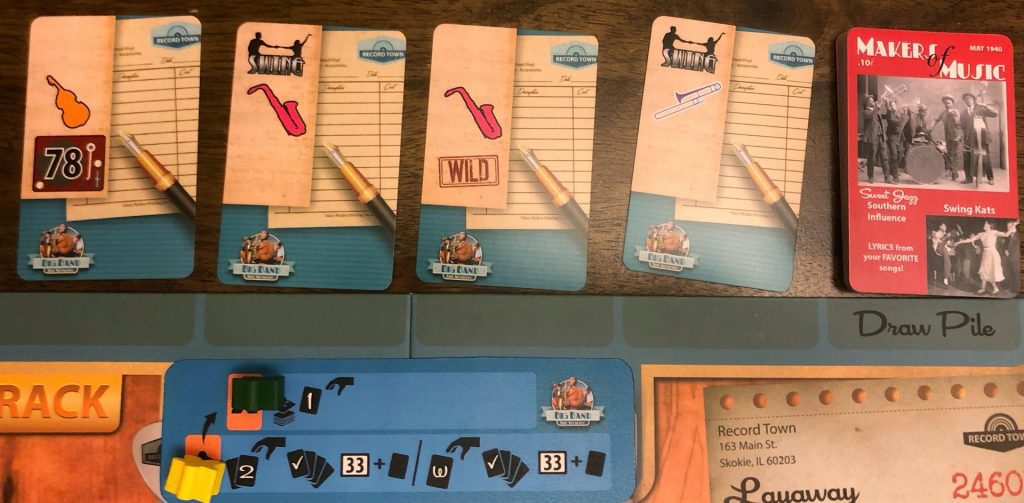The smash hit Vinyl, which already came with a wave of expansions after its Kickstarter success, is heading back to Kickstarter with a new one. Vinyl: Big Band trades the electric guitars and cowboy boots of the original for the smooth jazz and sultry swing of an earlier era. So what exactly makes Vinyl: Big Band so much bigger and…bandier?
Jazzing It Up
If you’re not familiar with Vinyl, I strongly recommend bopping over to the Vinyl review I wrote last year for a lengthier look at the gameplay and theme. The basic idea is that players are record collectors crowding the aisles of their favorite record store. Each player uses their lone meeple to occupy locations on the board where, among other things, they can gather cards with various icons and spend those cards to buy albums for their collection. What made the original Vinyl such a rockin’ good time (besides Talon Strikes’ high fidelity to the theme) was the bump mechanic that allowed players to claim an already occupied spot at the cost of giving the bumped player a free action. All of those elements are still intact in this new version.

Big Band, though, takes an already fun game and ratchets it up to 11 by adding some major changes: a new way to organize collections, playback speeds that impact the actions players can take, and a “leaderboard”, which grants players bonus actions and points for pursuing certain artists.
Stacks of Wax
The changes to collections are the easiest to understand. The original Vinyl had players building collections of records along 3 types: Pure, Mixed, and Double Mixed. Pure collections had the same genre (like Country) and 1 other consistent trait (like being from the ‘50s). Mixed collections had to have multiple genres and either 1 or 2 consistent non-genre traits for Mixed and Double Mixed, respectively. If that sounds a bit complicated, you’ll appreciate how Big Band changes the collection rules.

Players now have two active collections at all times: Swing and Jazz. At any point, they can use the Front Counter location to retire (score) a set of 4 cards from one of those. A retired collection must include 1 each of the 4 instrument types — think of it as making a full band — and must share the same genre (either Swing or Jazz). They may also be consistent along 0, 1, or 2 other traits. The two other traits are the band leader (of which there are 8, making it difficult to get 4 of a kind) and playback speed (33 or 78). Both of these traits are tied to the other major mechanical changes.

This is a big improvement, especially for first-time players. In the original game players could only have two collections at any time but they had to turn in all of a collection to score it. Taking a record that didn’t fit their current collections could cost a lot of points in the end, leading to some tough choices on when to retire. In this edition players are always free to keep picking up things they might want down the road, but that doesn’t mean that the choices get easier. Having to spend an action to retire a collection adds a different kind of timing to master and the complication of playback speeds makes getting the perfect collection more difficult than it sounds.
The Speed of Sound
Playback speeds are one of the traits found on each record and retiring 4 of a matching speed earns more points. What makes this tricky is that each player also tracks their current playback speed based on the record they most recently purchased. Each speed has its own action location for the Record Bin so players buying records don’t bump each other as long as they’re at different speeds. Picking up a record that doesn’t match the player’s speed costs more and shifts the player into the other speed. One advantage of being at 33 is that the player can draw an extra card at the Magazine Rack location, where players get new cards to spend. To balance this all the 78 records are worth a little bit more than their counterparts, making them a better investment for the same price. Players need to jump between the 2 speeds effectively to make the most of their time in the store.

Overall, the playback speed mechanic is fun and clever. I love the idea of “stance dancing” to take advantage of opportunities as they arrive. However, some players hate having to pay extra costs for minor rewards and they will definitely dislike this feature of the game. While players don’t have to switch speeds, not doing so may lead to frustration and wasted turns. There’s also a bit of a thematic disconnect here as to why the players themselves are changing speeds. The closest we could come is that 33s and 78s were sometimes displayed in different sections of the store, which isn’t precisely true in the game. Vinyl’s overwhelming strength is in the way it ties its theme to every element of gameplay so even this slight misstep feels larger than it really is. Once players get the hang of it, though, the addition of speeds opens up enough interesting decisions that it’s easy to overlook these minor quibbles.
Climbing the Charts
The last major addition to Vinyl: Big Band is the leaderboard. This bonus board tracks the popularity of the various band leaders found on the records. Each time the store is refilled, 2 band leaders are pushed 1 or more squares up the leaderboard track. There are brackets along the track that show different actions; whenever a player retires a collection, they may take the matching leaderboard action for any one band leader in the retired collection. Interestingly the strongest actions are at the bottom of the track: getting into a band leader “before they were cool” actually pays off!
I’ll admit that the leaderboard struck me as the most exciting thing when I first opened the box, so it’s unfortunate that in my playthroughs it never quite clicked. The first issue I have is with how the leaders move up the track. Whenever the store refills, two spare records are placed on the “window display” section of the board. These records can’t be purchased until the next refill. The players then look at each record and convert the instrument symbol found there to the appropriate number of spaces to move the band leader from that record.

It’s a little clunky and it’s made worse by the fact that moving the various leader chits is a bit finicky. There are 8 leaders, each represented by a small chit with even smaller writing, moving along a track of 16 spaces. Having more than 1 leader on a space is incredibly common yet makes it difficult to read at a glance. And woe betide the poor soul who accidentally bumps the board or table and has to reconstruct the track from memory!
More to the point, it’s really hard to synergize the players’ collections with the leaderboard. As any given leader might move up 0-8 spaces when the store is refilled, it’s next to impossible to plan around until the moment you’re ready to retire a collection. Getting bonus actions is always a good thing, yet I never felt like I had much control over them. The points earned at the end feel the same way. Players get 2 points for each record they have of the top-ranking band leader and 1 point for each of the second-ranking leader, but outside of the last few rounds players have no way to know whether they’d be eligible. Having some way to influence or control the track would go a long way towards making this new addition feel more impactful. The upshot of all this is that the leaderboard is easy to skip over if you don’t like it. It has no significant effect on the other new aspects of the game. I’d still recommend giving it a try first, especially since the mechanic may change before production.
If It Ain’t Got That Swing
Outside of the leaderboard issues I really enjoyed Vinyl: Big Band. While the prototype version I saw didn’t have final artwork, I’m more than confident that Talon Strikes will deliver the goods based on their track record. For me the theme probably isn’t as appealing, yet for swing or jazz fans who will catch all the subtle jokes and details I’d expect from a Vinyl title, it’s definitely going to be a winner.

If you’ve never played the original and don’t have a strong preference for theme I’d definitely recommend picking up this expansion. Most of the changes here make it both more interactive and more fun. While I missed the secret collection goals of the first title, this is a puzzlier and, frankly, better version of an already great game. If you have played Vinyl before, then Big Band is definitely worth playing to see if this new version can replace the old standard.
Swing on over to the Kickstarter right now to pick up Vinyl: Big Band!











Add Comment